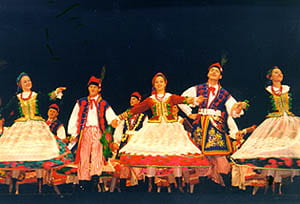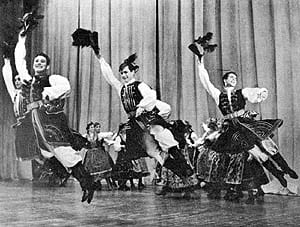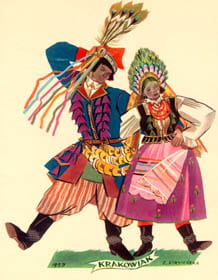Essay by Maja Trochimczyk
History
Krakowiak is a Polish dance from the region of Kraków, the old capital of Poland (used by the Piast and the Jagiełło dynasties) and the center of southern part of the country, called Małopolska (Little Poland). The common name used in English is cracovienne (from the French); in German the dance is known as Krakauer Tanz.
The term refers to a group of dances from southern and central Małopolska, which are known by their places of origin (proszowiak from Proszów), or by the particular figures used in their choreography. According to the entry in The New Grove Dictionary of Music and Musicians (1980 ed.), “in its origins, the krakowiak seems to be connected with courtship ritual.”
The dance dates back to the 16th and 17th centuries when it was included in organ and lute tablatures, as well as songbooks, under such titles as Chorea polnica or Polnish Tanz.
However, the first time that the name itself appeared in print was in Franciszek Mirecki’s 1816 piano album, Krakowiaks Offered to the Women of Poland (Warsaw, 1816). In the mid-19th century, the krakowiak became a popular ballroom dance in Austria and France and grew to be regarded as a “national dance” of Poland (it competed with the polonaise). For Poland, this was the time of partitions and the unsuccessful uprisings (1831, 1848) which sought to regain the country’s independence. The krakowiak, polonaise, and even mazurka, appeared in the Parisian salons as symbols of solidarity with the oppressed nation. At the same time, the krakowiak became a choice of composers who transformed it into an extensive and even virtuosic form, beginning from Fryderyk Chopin’s Krakowiak (grand rondeau de concert) for piano and orchestra (op. 14, 1828; including a quotation of the popular “Albośmy to jacy tacy”), and including pieces by Zygmunt Noskowski, Ignacy Jan Paderewski, and Roman Statkowski. As the result of this increased artistic stature, even the ballroom form of the dance grew in scope and the dance was transformed into a three-part form, with the music featuring a contrasting central section, and modulations to other keys.

Simultaneously with its shift to the concert hall, the krakowiak lost its popularity as a functional dance (of either the peasants, or the gentry). Instead, it became an impressive “exhibition” dance to be watched and applauded. The fast tempi and colorful costumes, perhaps the most decorative of all Polish folk-costumes, have contributed to the appeal of the krakowiak on the stage and its popularity as the finale in performances by Polish folk dance ensembles in the U.S.
The great popularity of the krakowiak among the American Polonia has antecedents in its widespread presence in American popular music since mid-19th century. A famous Austrian dancer, Fanny Elssler, presented the Cracovienne for her debut in New York: dressed in red boots, blue shirt, white jacket and velvet cap, she delighted her audiences and secured the position of this dance in the American popular repertoire. Aleksander Janta lists 32 Cracoviennes, 4 songs Cracovian Maid, and 5 Krakowiaks in his inventory of Polish dances composed in the U.S. at that time (A History of Nineteenth Century American-Polish Music, p. 114-124).
Description
In terms of its choreography, the krakowiak is set for several couples, among whom the leading male dancer sings and indicates the steps. According to the description in the New Grove Dictionary of Music and Musicians, the krakowiak is directed by the leading man from the first pair. As they approach the band, “the man, tapping his heels or dancing a few steps, sings a melody from an established repertory with newly improvised words addressed to his partner. The band follows the melody, and the couples move off in file and form a circle (with the leading couple back at the band). Thereafter verses are sung and played in alternation, the couples circulating during the played verses.”
There are several figures which appear in the different stages of the dance: the invitation phase, the running, the shuffling, the passing, etc. The three most characteristic steps are: the galop (fast running forward), the hołubiec (jump with clicking the heels and stamping; pl. hołubce), and the krzesany (this term is used as a name of a separate dance in the Podhale area, but here refers to a sliding motion of the feet with stamping).

The krakowiak is the exhibition dance of choice of the Polish-American dance ensembles. When performed on the stage, it includes a variety of group figures, in addition to the turns, jumps, running and stamping steps. A photo of the figure of the Star (or the Cross; the dancers hook their arms and rotate around a central point in tightly-held rows of alternating men and women) as performed by the Podhale Polish Folk Dance Company in 1999 is included below, in the section about the music.
A regional variant from the Nowy Sącz area in south-eastern Poland, called Krakowiaki Sądeckie (in the plural form of the noun), is a dance for men only. It consists of a series of krakowiak tunes and is a display dance performed in a line, or semi-circle. Its choreorhythmic and musical features place it in-between the dances of the lowlands (Kraków itself) and the mountains (Podhale area). More information about this dance is provided by Ada Dziewanowska in Polish Folk Dances and Songs.
Costumes
The strój krakowski (Kraków costume) is the favourite among the various regional costumes of Poland and has come to symbolize the traditional costume of Poland in general, especially abroad.

The women wear white shirts with broad sleeves and collars decorated with lace, colorful vests with sequins and rich embroidery, strings of coral beads, flowery skirts in bold patterns, partly covered with white lace aprons (plus multiple petticoats underneath), and wreaths of flowers with multi-colored ribbons in their braided hair (girls) or colorful, flowery kerchiefs (mature women). The high-laced red boots have heels with metal tips, to emphasize each stamp, click, or jump.
The men wear long, dark and embroidered coats over white shirts, striped pants (red-white; the pants are tucked into the high red boots), and embroidered vests. Their characteristic accessories include a special belt with decorative strings of small, jingling metal plates, as well as a square hat, topped with peacock feathers.
The costumes are lavishly ornamented, one could almost say that the effect of multicolored skirts, vests and embroidery is somewhat similar to the extravagant colorfulness of the peacock.
Music
The krakowiak is a fast dance in duple meter; it uses a characteristic syncopated pattern of short-long-short (or eight-note – quarter-note – eight-note) which allows one to recognize the dance form quite easily. Another variant is an eighth-note followed by an accented dotted quarter-note; both are illustrated below:

This pattern alternates with the simpler rhythm of two eighth-notes, plus one quarter-note (or: short-short-long). The phrases are symmetrically arranged in pairs of four measures each, though the texts of songs used in the krakowiak are grouped in four lines of six-syllables each. The melodies feature a great variety of patterns, with added extra notes, dotted rhythms, and passages based on triads.
In its more complex, stylized form, developed under the influence of art music composers and the requirements of the theatrical stage (krakowiak was a popular exhibition dance), krakowiak became a three-part form, using repetition and modulation to extend the outer sections, and containing a contrasting middle section, as well as modulating links in between. The krakowiaks danced by State Folk Song and Dance Ensembles, Mazowsze and Śląsk belong to the latter category.
Sources of Material
- Dziewanowska, Ada. Polish Folk Dances & Songs: A Step by Step Guide. New York: Hippocrene Books, 1999.
- Cooley, Timothy. Notes for Fire in the Mountains CD of Polish Highland Bands (1927-50), Yazoo 7013; 1997.
- Harley, Maria Anna. “Dance as a National Symbol: Polish Dance in Southern California.” Project for Southern California Studies Center at USC, August 2000.
- Janta, Aleksander. A History of Nineteenth Century American-Polish Music New York: The Kosciuszko Foundation, 1982.
- “Krakowiak,” entry in the New Grove Dictionary of Music and Musicians, vol. 10. Stanley Sadie, ed. London: McMillan, 1980.
Illustrations from Polish folk art (straw cutouts); Zofia Stryjeńska’s 1927 “Krakowiak” image; photographs from PMRC Collection and from archival material gathered for M.A. Harley’s Polish Dance in Southern California project.
